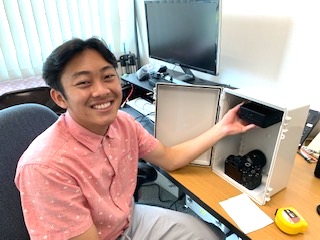
Christopher Chock was born and raised on the Big Island of Hawai’i. After graduating from Hawai’i Preparatory Academy in 2019, he attended Gonzaga University and is pursuing a major in Electrical Engineering with a minor in Physics. He plans to enter a workforce that innovates emerging technology, such as circuit design or developing new instruments. Eventually, he aspires to return to Hawai’i and further his growth. In his spare time, Christopher enjoys indoor climbing, soccer, volleyball, and piano.
Home Island: Big Island of Hawai’i
High School: Hawai’i Preparatory Academy
Institution when accepted: Gonzaga University
Akamai Project: Deployment of a Highly Sensitive Video Camera for Astronomical Observations
Project Site: Subaru Telescope. Hilo HI
Mentors: Olivier Guyon, Preethi Krishnamoorthy, Wilfred Tyler Gee and Ichi Tanaka
Project Abstract:
The objective of this project was to deploy a video system that transfers uncompressed RAW data with a resolution of 3840 x 2160 (4K resolution), 10-bit 4:2:2 video, and up to 60 fps into two systems: a Next Unit of Computing (NUC) computer for live streaming and a remote computer for data analysis. The Asahi Shinbun Camera system atop Maunakea provides a continuous live stream in 1920 x 1080 resolution. Although the system is well positioned to gather data, the data quality is insufficient for analysis, such as estimating a meteor’s 3D trajectory. To build the higher-resolution system, the Panoptic Astronomical Networked Observatories for a Public Transiting Exoplanets Survey (PANOPTES) project coordinated with the Asahi Shinbun Camera system. The PANOPTES system captured the desired uncompressed data by connecting a USB Capture Card (Magewell 4K Plus), computer, and Sony ? (alpha) 7s iii camera. This capture card allowed the streaming computer to receive data in 4K at 30 fps. We analyzed the camera’s settings and utilized OBS Studio to confirm that raw data was received. Next, I led the mechanical design phase to deploy our system. The camera, capture card, and computer were assembled in a weatherproofed box and mounted at the Mauna Loa observatory. Inside, a thermal-sensing fan and surge-proof power source were included to maintain temperature and power. Additionally, the capture card contains a secondary HDMI-passthrough output that can send data up to 4K resolution at 60 fps. In the future, the PANOPTES project will send the camera’s high-quality, raw data to an external computer for scientific analysis.